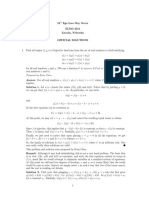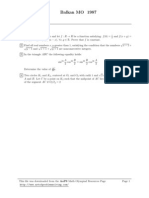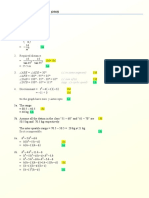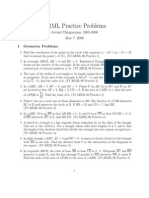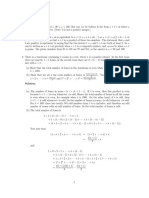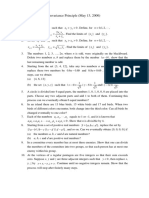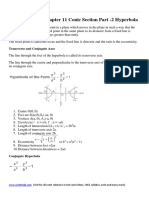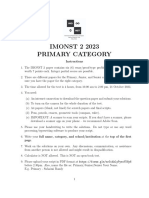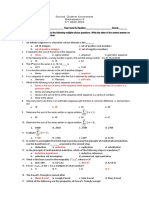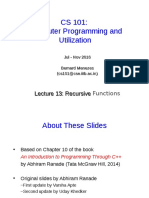Algebra: Advanced Level Pure Mathematics
Algebra: Advanced Level Pure Mathematics
Uploaded by
Nur HidayahCopyright:
Available Formats
Algebra: Advanced Level Pure Mathematics
Algebra: Advanced Level Pure Mathematics
Uploaded by
Nur HidayahOriginal Title
Copyright
Available Formats
Share this document
Did you find this document useful?
Is this content inappropriate?
Copyright:
Available Formats
Algebra: Advanced Level Pure Mathematics
Algebra: Advanced Level Pure Mathematics
Uploaded by
Nur HidayahCopyright:
Available Formats
Mathematical Induction Advanced Level Pure Mathematics
Advanced Level Pure Mathematics
Algebra
Chapter 3
3.1 3.2
3
2 9
Mathematical Induction
First Principle of Mathematical Induction Second Principle of Mathematical Induction
3.1 First Principle of Mathematical Induction
Prepared by K. F. Ngai Page
Mathematical Induction Advanced Level Pure Mathematics
Definition
Let P (n) be a proposition on an integer variable n. Then P (n) is true for all integers n s if and only if the following two conditions are both satisfied : (i) ii) P (s) is true , If P (k ) , where k s , is assumed to be true, then P (k + 1) is true .
Example 1
Prove that for all positive integers n , (13 + 2 3 + 33 + + n 3 ) + 3(15 + 2 5 + 35 + + n 5 ) = 4(1 + 2 + 3 + n) 3
Example 2
Prove, by induction, that 1 1 1 1 1 1 1 1 + + ... + = 1 + + ... + n +1 n + 2 2n 2 3 4 2n 1 2n
Prepared by K. F. Ngai Page
Mathematical Induction Advanced Level Pure Mathematics
for all positive integers n. (1) When n = 1, L.H.S. = 1 2 1 1 = 2 2
R.H.S. = 1
Hence, the proposition is true for n = 1. (2) Assume the proposition is true for n = k , k 1. i.e. 1 1 1 1 1 1 1 1 + + ... + = 1 + + ... + k +1 k + 2 2k 2 3 4 2k 1 2k
When n = k + 1, L.H.S. = 1 1 + + ... + k +1 k + 2 1 + 1 + 1
Hence, the proposition is also true for n = k + 1. By the Principle of Mathematical Induction, the proposition is true for all positive integers n. Example 3 A sequence a1 , a2 , , an is defined as follows : a1 = 1 , a2 = 2 and an+2 = an+1 + an for n 1. Prove, by induction, that an+12 an an+2 = ( n1 for all positive integers n. 1)
Prepared by K. F. Ngai Page
Mathematical Induction Advanced Level Pure Mathematics
Example 4
Given a sequence u1 , u 2 , , u n , such that u1 = 1 and u n = u n 1 + 3 , ( n 2) . Show that u n = 3n 2 , for all positive integers n .
Prepared by K. F. Ngai Page
Mathematical Induction Advanced Level Pure Mathematics
Example 5
Prove that for any positive integer n , there exist unique positive integers an and bn such that (1+ 3 )n = an + bn 3 .
(1)
Want to prove the existence of integers an and bn .
(2)
Want to prove the uniqueness of integers an and bn .
Prepared by K. F. Ngai Page
Mathematical Induction Advanced Level Pure Mathematics
Example 6
Prove, by induction, that n(n2 + 5) is divisible by 6 for all positive integers n.
(1)
When n = 1, n(n2 + 5) = 1 6 = 6 Hence, the proposition is true for n = 1.
(2)
Assume the proposition is true for n = k , k 1 i.e. k(k2 + 5) = 6m where m is an integer.
When n = k + 1, n(n2 + 5) = (k+1)[(k+1)2 + 5]
[ Hint : For any integers n ,
n(n + 1) is also an integer. ] 2
Modification of The First Principle of Mathematical Induction Definition If a proposition P(n) is true for a positive odd/even integer s and that P(k) is true implies P(k+2) is also true, then P(n) is true for all positive odd/even integers n s. Example 7 Prove, by mathematical induction, that 5 n 2 n is divisible by 21 for all positive even integers n.
Prepared by K. F. Ngai Page
Mathematical Induction Advanced Level Pure Mathematics
Example 8
Prove, by mathematical induction, that 5 n 3 n 2 n is divisible by 30 for all positive odd integers n greater than 1.
Prepared by K. F. Ngai Page
Mathematical Induction Advanced Level Pure Mathematics
3.2 Second Principle of Mathematical Induction
Definition Let P(n) be a proposition involving positive integers n. If (i) (ii) P(n) is true for n = 1 and n = 2 , and
if P(n) is true for some positive integer k and k+1, then P(n) is also true for n = k+2, then P(n) is true for all positive integers n.
Example 9
A sequence of real numbers a1 , a2 , , an , is defined by a0 = 0 , a1 = 1 and an+2 = n+1 + an for all n = 0 , 1 , . a Show that for all non-negative integers n , an = 1 5 ( n n )
where , are roots of the equation x2 + x 1 = 0 with > .
Prepared by K. F. Ngai Page
Mathematical Induction Advanced Level Pure Mathematics
[ Hint : is a root of the equation x2 + x 1 = 0 2 + 1= 0. ] Example 10 A sequence of real numbers a 0 , a1 , , a n , is defined by a 0 = 1, a1 = 7 and a n + 2 4a n +1 + 3a n = 0 for n = 0,1,2, Prove, by induction, that a n = 3 n +1 2 for all non-negative integers n .
Prepared by K. F. Ngai Page
Mathematical Induction Advanced Level Pure Mathematics
Example 11 Consider the sequence {Un } in which U1 = 0 , Un +1 = 2n Un for n = 1, 2, . Using mathematical induction or otherwise, show that 2Un = 2n 1 + ( n for n = 1, 2, . 1) Hence find lim
n
Un n
[HKAL92]
Prepared by K. F. Ngai Page
10
Mathematical Induction Advanced Level Pure Mathematics
Example 12 Let U1 = 1 , U2 = 3 and Un = Un2 + Un1 for n 3 . Using mathematical induction, or otherwise, prove that Un = n + n for n 1 , where and are the roots of x2 x 1 = 0 . [HKAL93]
Example 13
Let {an} be a sequence of positive numbers such that 1 + an a1 + a2 + + an = 2
2
for n = 1, 2, 3, .
Prepared by K. F. Ngai
Page
11
Mathematical Induction
Prove by induction that an = 2n 1 for n = 1, 2, 3, .
Advanced Level Pure Mathematics
[HKAL94]
Example 14 Let {an } be a sequence of real numbers, where it is defined by a0 = 1 , a1 = 6 , a2 = 45 and an an+1 an+2
1 3
1 an+3 = 0 for n = 0, 1, 2, . 27
[HKAL97]
Using mathematical induction, or otherwise, show that an = 3n(n2 + 1) for n = 0, 1, 2,
Prepared by K. F. Ngai Page
12
Mathematical Induction Advanced Level Pure Mathematics
Example 15 Let , be the roots of x 2 14 x + 36 = 0 . Show that n + n is divisible by 2 n for n = 1,2,3,
Example 16
A sequence {an} is an increasing sequence of positive numbers. Suppose sequences {bn} , {cn} are defined such that b1 = c1 =
1 1 a1 , bn = (an1 + cn1) and cn = a n1bn1 for n 2 . 2 2
Show by induction that (a) (b) bn < bn+1 and cn < cn+1 . bn < an and cn < an for n 1 .
(a)
Want to prove bn < bn+1 and cn < cn+1.
Prepared by K. F. Ngai Page
13
Mathematical Induction Advanced Level Pure Mathematics
When n = 1 b2 = = = >
1 (a1 + c1) 2 1 1 (a1 + a1) 2 2 3 a1 4 1 a1 = b1 2
c2 = a1b1 =
Hence, the proposition is true for n = 1. Assume bk < bk+1 and ck < ck+1 for k 1. When n = k+1, bk+2 bk+1 = = ck+2 ck+1 =
1 1 (ak+1 + ck+1) (ak + ck) 2 2 1 1 (ak+1 ak) + (ck+1 ck) 2 2
>0 bk+1 < bk+2
Prepared by K. F. Ngai Page
14
Mathematical Induction Advanced Level Pure Mathematics
Example 17 A sequence of real numbers {an} is defined as follows : a0 = a1 = 1 , a2 = 3 and an+3 = 3an+2 an+1 2an for n = 0, 1, 2, . (a) Let bk = ak+2 ak+1 ak for k = 0, 1, 2, . Prove that bn = 2bn1 for all n N. (b) Hence, or otherwise, deduce that an 2n for all n = 0, 1, 2, .
Prepared by K. F. Ngai Page
15
You might also like
- Sequences and Series Integral Topic AssessmentDocument6 pagesSequences and Series Integral Topic AssessmentOrion BlaqueNo ratings yet
- A1 SolutionDocument5 pagesA1 SolutionGraciela MarquesNo ratings yet
- Binomial TheoremDocument26 pagesBinomial TheoremIsmail HashimNo ratings yet
- 2010 TJC SolDocument12 pages2010 TJC SolPooja KapurNo ratings yet
- Mathematical Problem SolutionsDocument8 pagesMathematical Problem Solutionsrafael859No ratings yet
- Maths Mock 5, Paper 2 (3005)Document14 pagesMaths Mock 5, Paper 2 (3005)Yongcheng LiuNo ratings yet
- Maths Mock 2, Paper 2 (3002)Document14 pagesMaths Mock 2, Paper 2 (3002)Yongcheng LiuNo ratings yet
- Question Bank Maths Class 10Document73 pagesQuestion Bank Maths Class 10anshhatesyouNo ratings yet
- 2022 Aime IIDocument5 pages2022 Aime IIamri saifNo ratings yet
- HKMO SeriesDocument30 pagesHKMO SeriesAnhTamNo ratings yet
- Prime FactorialDocument2 pagesPrime Factorialayu7kajiNo ratings yet
- ELMO 2014 SolutionsDocument8 pagesELMO 2014 SolutionsSancho PanchoNo ratings yet
- v21 n4 20180315Document4 pagesv21 n4 20180315John ChanNo ratings yet
- Copernicus 4th Math - Global Round Category 4 - English VerDocument7 pagesCopernicus 4th Math - Global Round Category 4 - English Vervy2b2549jtNo ratings yet
- Bulgarian Mathematical Olympiad 2006 Regional Round, April 15-16Document4 pagesBulgarian Mathematical Olympiad 2006 Regional Round, April 15-16ThePhuongNo ratings yet
- Vieta QDocument2 pagesVieta QPhil RoxNo ratings yet
- Usamo 1997Document2 pagesUsamo 1997JT3No ratings yet
- Balkan MO-1987Document1 pageBalkan MO-1987OklaNo ratings yet
- Jozsef Wildt 2014Document7 pagesJozsef Wildt 2014viosirelNo ratings yet
- LQ Suggested Solution & MC Anwser (3002)Document9 pagesLQ Suggested Solution & MC Anwser (3002)Yongcheng LiuNo ratings yet
- LQ Suggested Solution & MC Anwser (3003)Document9 pagesLQ Suggested Solution & MC Anwser (3003)Yongcheng LiuNo ratings yet
- 2013 Contest Final VersionDocument38 pages2013 Contest Final VersionQuang Đào VũNo ratings yet
- Mathematics Olympiad Combinatorics PDFDocument7 pagesMathematics Olympiad Combinatorics PDFPrashant BhattNo ratings yet
- Balkan MO-1986Document1 pageBalkan MO-1986OklaNo ratings yet
- Advanced Analysis-Min YanDocument616 pagesAdvanced Analysis-Min Yankurisu_jpNo ratings yet
- Calculus I: Advanced Level Pure MathematicsDocument23 pagesCalculus I: Advanced Level Pure MathematicsKelvin CheungNo ratings yet
- Perfect Square PDFDocument14 pagesPerfect Square PDFPebamdaso DasoNo ratings yet
- VectorsDocument30 pagesVectorsbd87glNo ratings yet
- Arml Practice ProblemsDocument6 pagesArml Practice Problemsapi-296129377No ratings yet
- Senior Solutions: SolutionDocument4 pagesSenior Solutions: SolutioncuongaccNo ratings yet
- Senior Kangaroo 2021 PaperDocument4 pagesSenior Kangaroo 2021 PaperAB IVNo ratings yet
- B) SMC - Number Theory QuestionsDocument2 pagesB) SMC - Number Theory QuestionsHaoyu WangNo ratings yet
- H2 Math Topical Worksheet (Complex Numbers)Document2 pagesH2 Math Topical Worksheet (Complex Numbers)Tim Gan MathNo ratings yet
- MOP Homework 2015Document7 pagesMOP Homework 2015asdas100% (3)
- OLYMPIAD PROBLEMS ALGEBRA VOLUME II - CompressedDocument225 pagesOLYMPIAD PROBLEMS ALGEBRA VOLUME II - Compressedsoaresadao177No ratings yet
- Exercises On InvariantsDocument2 pagesExercises On InvariantsBenjamin Benicarlo Juanillo IIINo ratings yet
- Class 11 Maths Chapter 11 Conic Section Part 2 Hyperbola Download in PDFDocument9 pagesClass 11 Maths Chapter 11 Conic Section Part 2 Hyperbola Download in PDFMohsin Manzoor Bhat100% (1)
- PUMaC2013 NumberTheoryBSolDocument3 pagesPUMaC2013 NumberTheoryBSolau auNo ratings yet
- Aops Community 1985 Aime ProblemsDocument3 pagesAops Community 1985 Aime ProblemsAmanNo ratings yet
- 2012 Euclid SolutionDocument15 pages2012 Euclid SolutionleeaccountNo ratings yet
- AMC10 24factors Notes BlankDocument15 pagesAMC10 24factors Notes BlankJimmy ZhangNo ratings yet
- Number PatternsDocument2 pagesNumber PatternsAnhTamNo ratings yet
- 2012 Hs ContestDocument7 pages2012 Hs ContestJohn TafuiNo ratings yet
- BMO 2011 ProblemsDocument1 pageBMO 2011 ProblemsjfmarquesNo ratings yet
- 2006 6 ProblemsDocument4 pages2006 6 ProblemsAn Phu PhamNo ratings yet
- Ioqm 2 PDFDocument4 pagesIoqm 2 PDFShakir MommandNo ratings yet
- 2014 Korea InternationalDocument11 pages2014 Korea InternationalRefeniaUsmanNo ratings yet
- Exponential and Logarithmic Function (Q)Document29 pagesExponential and Logarithmic Function (Q)Belladonna LeeNo ratings yet
- More About Trigonmetry (II) (Q)Document44 pagesMore About Trigonmetry (II) (Q)Chan Kwan Yu QuinnyNo ratings yet
- China South East Mathematical Olympiad 2011 68Document2 pagesChina South East Mathematical Olympiad 2011 68Kem SochetraNo ratings yet
- Materi 1-Berbakat A08-MTK-Pertemuan 18 - Kapita Selekta 6-1686023805Document2 pagesMateri 1-Berbakat A08-MTK-Pertemuan 18 - Kapita Selekta 6-1686023805Yumna Sa'diyyahNo ratings yet
- Vertex Naming Angles: Flash Cards ÷9 and Set H Speed Drill 4, Page 62Document10 pagesVertex Naming Angles: Flash Cards ÷9 and Set H Speed Drill 4, Page 62Careen S AlicawayNo ratings yet
- SMO Open 2022Document6 pagesSMO Open 2022劉星雨No ratings yet
- Balkan MO 2006: Nicosia, CyprusDocument1 pageBalkan MO 2006: Nicosia, CyprusOklaNo ratings yet
- Balkan MO-1989Document1 pageBalkan MO-1989OklaNo ratings yet
- MR 1 2014 ProblemsDocument4 pagesMR 1 2014 ProblemsLêNhậtHoàng0% (1)
- China China Girls Math Olympiad 2008Document2 pagesChina China Girls Math Olympiad 2008PremMehtaNo ratings yet
- Algebra SDocument7 pagesAlgebra Sสฮาบูดีน สาและNo ratings yet
- IMONST2 2023 Primary Solutions and DiscussionDocument14 pagesIMONST2 2023 Primary Solutions and DiscussionKhoon Yu Tan100% (1)
- Acfrogaq Acf1iot6 Jfivlxops9osasut 4rautrm6rljobadi83w4lckjonlryex9q472goe4jacovmyxj0l Gziz Y53ibyau2cuh4dslsdw4qyvmtym6qeflvjdqgquvfxvl6ty7tj1evg1zDocument4 pagesAcfrogaq Acf1iot6 Jfivlxops9osasut 4rautrm6rljobadi83w4lckjonlryex9q472goe4jacovmyxj0l Gziz Y53ibyau2cuh4dslsdw4qyvmtym6qeflvjdqgquvfxvl6ty7tj1evg1zabrm33167No ratings yet
- Aaa 3Document39 pagesAaa 3Muhammad Khaleel AfzalNo ratings yet
- Principle of Mathematical InductionDocument11 pagesPrinciple of Mathematical InductionStephenNo ratings yet
- Proof TheoryDocument13 pagesProof TheorySophiaSun100% (1)
- 2022 Specialist Mathematics Subject Assessment AdviceDocument10 pages2022 Specialist Mathematics Subject Assessment Advicejeremysh17No ratings yet
- (MAA 1.9) MATHEMATICAL INDUCTION - EcoDocument6 pages(MAA 1.9) MATHEMATICAL INDUCTION - EcoAarishiNo ratings yet
- SolutionsDocument107 pagesSolutionseyuel.ap24No ratings yet
- TOC Chapter-1 SRG - FinalDocument93 pagesTOC Chapter-1 SRG - FinalGiri ShayakNo ratings yet
- Isye 6761 - Fall 2012Document11 pagesIsye 6761 - Fall 2012Kirby NgNo ratings yet
- Mathematical InductionDocument10 pagesMathematical InductionJonnifer QuirosNo ratings yet
- Math InductionDocument16 pagesMath InductionthonhiNo ratings yet
- Chapter 01. PreliminaryDocument28 pagesChapter 01. Preliminarykims3515354178No ratings yet
- CS6503 Theory of Computations Unit 2Document47 pagesCS6503 Theory of Computations Unit 2dgk84_id67% (3)
- David Liu NotesDocument79 pagesDavid Liu NotesEdward WangNo ratings yet
- Week 5 - Induction and Recursion: Richard Earl Mathematical Institute, Oxford, OX1 2LB, November 2003Document15 pagesWeek 5 - Induction and Recursion: Richard Earl Mathematical Institute, Oxford, OX1 2LB, November 2003Himraj BachooNo ratings yet
- MTH202 Quiz-3 by Vu Topper RMDocument16 pagesMTH202 Quiz-3 by Vu Topper RMdanish3175040486No ratings yet
- 09-Methods of ProofDocument71 pages09-Methods of ProofLee Ann VillanuevaNo ratings yet
- Discrete MathematicsDocument11 pagesDiscrete MathematicsRohit SuryavanshiNo ratings yet
- Notes From "How To Prove It: A Structured Approach" by Daniel J. VellemanDocument7 pagesNotes From "How To Prove It: A Structured Approach" by Daniel J. VellemanTestNo ratings yet
- NCERT Solutions For Class 12 Maths Chapter 5 Continuity and Differentiability Miscellaneous ExerciseDocument20 pagesNCERT Solutions For Class 12 Maths Chapter 5 Continuity and Differentiability Miscellaneous ExerciseAnjali MehraNo ratings yet
- PRECAL 60 Items (2nd)Document5 pagesPRECAL 60 Items (2nd)Marylyd tiuNo ratings yet
- Amazing Properties of Binomial Coeffcients PDFDocument23 pagesAmazing Properties of Binomial Coeffcients PDFchicodesouzaNo ratings yet
- The Surreals Contain The PlumpDocument4 pagesThe Surreals Contain The PlumpVaclav VopravilNo ratings yet
- Discrete MathematicsDocument3 pagesDiscrete MathematicsSobhan DasariNo ratings yet
- Mathematical InductionDocument2 pagesMathematical InductionNaveen KumarNo ratings yet
- The Period of The Fibonacci Sequence Modulo JDocument12 pagesThe Period of The Fibonacci Sequence Modulo JAmar dattaNo ratings yet
- CS270 SyllabusDocument3 pagesCS270 SyllabusJai VaseNo ratings yet
- English Hindi DictionaryDocument31 pagesEnglish Hindi DictionaryRajNo ratings yet
- 3.1 Definition of A Group: Solved Problems: SolutionDocument12 pages3.1 Definition of A Group: Solved Problems: SolutionNicolas OhinaNo ratings yet
- COMSC1-Discrete Structures 1 021920Document8 pagesCOMSC1-Discrete Structures 1 021920Glenn Josue FrencilloNo ratings yet











